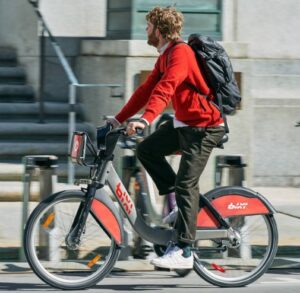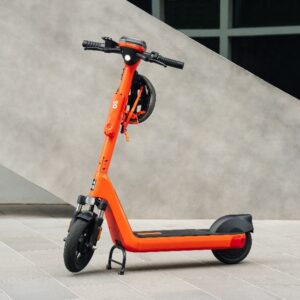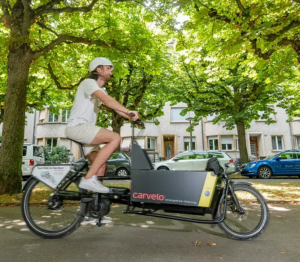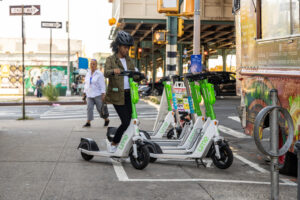Author: Daniel Romm
A key challenge for public transit systems is helping people get from their home to the transit system, and from the transit system to their final destination. Solving this “last-mile problem” is crucial for bringing about the mass adoption of public transit for commuting. An added hurdle to solving the last-mile problem, given that a significant proportion of national carbon emissions results from transportation,1 is doing so using transport modes that produce fewer greenhouse gas emissions than automobiles.
Working with Metrolinx, Ontario’s Greater Golden Horseshoe Area’s regional transportation agency (operating the GO Rail and Bus systems), the Platial Analysis Lab has been working to evaluate the potential of shared micromobility systems, such as bike-share and scooter-share, for addressing the last-mile problem. Shared micromobility systems are a potentially more sustainable and cheaper travel solution, compared with personal car use or a city investing in transit routes feeding into regional transit hubs.
Supporting micromobility use for connecting to public transit systems may be a low-cost policy solution to extend the catchment area (from which persons travel to a station) of transit systems, allowing more people to travel without using cars. In a Position Paper, we overview forms of shared micromobility systems, benefits and disbenefits of these systems for connecting to regional transit services, and their successful implementation.
Varieties in the Implementation of Shared Micromobility Systems
Table of contents:
- Types of Vehicles
- Types of Parking Systems
- Benefits and Disbenefits of Shared Micromobility
- Considerations for Implementing Shared Micromobility Systems
- Resources
- Related research from our group
Types of Vehicles
There are three varieties of vehicles used in nearly all shared micromobility systems globally: pedal-powered bicycles, e-bikes, and e-scooters.

The pedal-powered bicycle

(Source: https://bixi.com/)
The pedal-powered bicycle is the traditional vehicle used in shared micromobility systems. Typically, the bicycle is heavier, sturdier, and clunkier than personal bicycles, designed to withstand constant use with relatively little maintenance. Vehicles may have baskets attached to place belongings when riding.
The main advantage of the pedal-powered bicycle is in its relatively low cost, and in not requiring charging, that would be required with electric vehicles. Also, many travellers are already familiar with bicycles, and there are health benefits associated with riding pedal-powered bicycles.
The disadvantages of the pedal-powered bicycle are in the effort required for pedalling, which may dissuade some users. They are also less suitable for hilly terrain, since elevation drastically increases the physical effort needed to pedal.
The e-bike

(Source: https://citibikenyc.com/)
E-bikes are typically “pedal-assisted”, meaning that an electric motor amplifies the power of each pedal of the traveller, so that less effort is needed to move, especially on hills. Batteries in e-bikes must be charged by the system operator.
The advantage of e-bikes is in significantly reducing the physical exertion needed to use the vehicles. For people who might be dissuaded by the effort needed to ride a bicycle, whether because of disability, fitness, not wanting to sweat, etc., e-bikes are an attractive option. E-bikes are also better with hilly terrain than pedal-powered bikes, with the motor assisting climbing elevation.
The main disadvantage of e-bikes is that their batteries require charging. E-bikes can also more easily reach high speeds, and are heavier than pedal-powered bicycles, potentially posing a safety risk to others, though operators can place speed limiters on the vehicles.
The e-scooter

E-scooters are the newest entrants to shared micromobility systems and typically are used in dockless systems, but can also be used with docks. E-scooters can be two-, three-, or four-wheeled, and wheel thickness can vary as well, affecting the stability of the vehicle. Travellers stand on the board and use triggers at the handles of the vehicle to control an electric motor to propel and brake the vehicle. E-scooters are usually significantly lighter than both pedal-powered bicycles and e-bikes.
E-scooters have the advantage of being lightweight and small, both increasing the ease of use for some, and making it easier for operators to move vehicles around. They are user-friendly and intuitive, making the use of the system possible to those who do not know how to ride a bicycle. They also take up less public space, both when not in use and when in motion.
The disadvantages of e-scooters are largely those of e-bikes: because they are electric, they require constant charging. There also are safety concerns associated with e-scooters, both to the users and those around them, resulting from falls and collisions with other road users. By virtue of their size and light weight, they can be less stable than bicycles, especially on poorly maintained pavement surfaces. E-scooters may also struggle on steep inclines, though they typically handle fine with most hills in cities.
The cargo bike

(Source: https://carvelo.ch/)
The use of cargo bikes in shared micromobility systems is new in many parts of the world. Cargo bikes may be either pedal-powered or electric, and include a basket or wagon to allow travellers to haul cargo on their trip. They can be added as one potential vehicle option to complement a shared micromobility system.
The principal advantage of cargo bikes is in their added function of carrying cargo. Travellers needing to haul items (e.g., for buying groceries), who would otherwise not use a shared micromobility system, may be attracted by the option of cargo bikes. This may especially encourage shifting transport choices away from cars.
The disadvantage of cargo bikes is that they are larger and occupy more space.
Types of Parking Systems
Systems also vary by the parking system they use: where are travellers allowed to park vehicles after use? Shared micromobility systems must be “balanced”, meaning that vehicles are optimally placed to meet user demand, with minimal distance between where a person’s demand begins, and where the vehicle is parked. If a system is poorly balanced, the system may not serve users’ needs well. Ensuring system balance is necessary, which means that operators perform “rebalancing” operations, hauling their vehicles to different areas to meet changing user demand.
Anchor-based “docked” system

(Source: Taylor Simmons, https://cbc.ca/news/canada/toronto/toronto-bike-share-ridership-1.6946281)
These are the conventional system type and the one most people and municipalities are familiar with. In anchor-based, or “docked”, systems, vehicles are accessed from and returned to anchors or docks (stations), which typically lock, secure, and provide a mechanism for users to access the vehicles. There are usually terminals located at each dock to allow the user to pay and access the vehicle, but other mechanisms, such as QR codes attached to the vehicles themselves, are also possible.
The main advantage of docked systems is that when not in use, vehicles are orderly, parked in docks where space is already set aside for them. Operators may also benefit from vehicles being already grouped for pickup.
The disadvantages of docked systems include the cost of the docking infrastructure, which also adds a significant spatial and financial cost to expanding the system. Another disadvantage is that if there is an unplanned-for spike in demand, travellers may be faced with either a lack of available vehicles, or insufficient available docks. Both scenarios sharply reduce the usefulness of the system.
Free-floating “dockless” system

(Source: Lyft)
Free-floating, or “dockless”, systems remove the need for fixed docking infrastructure, instead using “smart lock” mechanisms that work with smart devices, allowing the vehicle to be unlocked and locked at any location. Users can locate vehicles and unlock them through the operator’s app, and later use the app to lock the vehicle.
The advantage of dockless systems is in increased flexibility and accessibility. Usually, someone’s demand for a micromobility trip doesn’t start and end exactly at a docking station. By distributing vehicles over space, a well-balanced system can more likely have vehicles closer to where travellers’ demand begins. Operators benefit from not needing docking infrastructure, as they can expand the system without the cost of installing new docks. The inherent flexibility also allows operators to relocate vehicles to address spikes in demand or supply, and there is no risk of travellers not finding an available dock to park in.
The disadvantage of dockless systems is in the disorder they may bring to city streets, as vehicles are not contained neatly in docking stations but are spread out over public space. Neat parking relies partly on good user behaviour, and when users park haphazardly, they risk disrupting public space, creating obstacles which especially pose a hazard to the visually impaired or those with mobility disabilities.
Hybrid systems

(Source: https://nycdotscootershare.info/)
Hybrid systems combine some features of docked and dockless systems. The simplest version of a hybrid system is including docking stations, but also allowing users park vehicles outside of docks, in the manner of a dockless system. Alternatively, operators may attach an extendable bike lock to the vehicle, requiring that users lock the vehicle to already-available fixed infrastructure on streets, effectively transforming existing infrastructure into “anchors” for vehicles. Another option is to paint “virtual” docks (or “corrals”) on sidewalks or streets, and require users to leave vehicles in these, verifying that they have done so with a picture or using geofencing technology. Geofencing refers to virtual geographic boundaries in which a vehicle must be parked, using GPS and/or RFID (Radio-Frequency Identification) to determine if a vehicle is within a geofence.
The advantage of hybrid systems is that, if well-designed, they combine the advantages of both systems and help address the challenges that exist with docked and dockless systems. A hybrid system allows for the convenience, flexibility, and accessibility of dockless systems while encouraging orderly parking around docking stations. The operator can more cheaply and easily expand the system without the requirement of the fixed infrastructure of docks. The challenge of docking stations having enough capacity to receive vehicles in the case of unexpected demand can also be addressed, in part, with hybridity, as users need not rely on docks.
The disadvantages of hybrid systems depend on how a system is hybridized, but often the problem is ensuring users follow the rules of the system, parking vehicles where operators allow. Operators have options for enforcing these rules (including geofencing, verifying orderly parking by requiring users take a photo of the parked vehicle, or imposing heavy penalties for user misbehaviour), but their effectiveness may vary depending on the particular circumstances of implementation.
Benefits and Disbenefits of Shared Micromobility
| Benefits | Disbenefits |
| Health benefits are associated with using micromobility, especially when replacing car travel, though it should be noted that some, but not all, of these benefits result from the physical activity needed for pedal-powered vehicles. Shared micromobility systems can support connecting to public transit. Micromobility systems extend the catchment area of public transit, improve overall accessibility, and reduce travel times. Travellers may have cost savings, as micromobility may be cheaper than alternatives. Shared micromobility can give cost savings to municipalities, especially when costs are offset by private firms. If the micromobility system lowers car use, the costs of expensive automobile infrastructure (i.e., road maintenance, parking, etc.) may be reduced. For transit agencies, supporting micromobility is a lower-cost alternative to expensive parking infrastructure, or expensive feeder bus routes. There are significant environmental benefits from reducing the pollution from car use. Shared micromobility systems may generate economic activity. There are time savings to users fromusing micromobility instead of walking. Decreasing car use contributes to reducing injuries and deaths from car collisions. Car infrastructure has an extremely high spatial cost, especially contrasted to the much more spatially efficient micromobility travel mode. Shared micromobility systems can reduce road traffic. Shared micromobility systems are often externally operated through private firms with experience and expertise in doing so, alleviating the burden of daily operations from municipalities. | Shared micromobility systems may replace public transit trips, thereby reducing fare revenues. The evidence for this is mixed, and varies geographically. Depending on how a system is implemented, and whether and how costs are offset by private firms, there may be financial costs associated with setting up a system, building supportive infrastructure, and operating the system. Different stakeholders have to purchase liability insurance coverage for shared micromobility systems. The risk of injury from micromobility travel is an important concern, especially with e-scooters. The material inputs of vehicles used in shared micromobility systems have an environmental cost, especially if policies are not put in place to conduct life-cycle assessments (LCAs) of these costs, and mitigate them through improved vehicle durability, repair policies, and good battery disposal processes. In the case of dockless systems, there may be messiness or disorder from haphazardly parked vehicles, infringing upon the public right-of-way and posing hazards to other travellers, especially those with visual or mobility disabilities. Addressing poor user behaviour requires additional efforts in compliance and enforcement by the operator and municipalities. Ensuring adequate paving quality and safe road conditions, for example through protected micromobility infrastructure, is important for micromobility traveller comfort and avoiding injuries. |
Considerations for Implementing Shared Micromobility Systems
Successfully implementing shared micromobility systems requires thoughtful cooperation among stakeholders, including:
- municipalities,
- provincial agencies,
- municipal and regional transit agencies,
- micromobility operators,
- large landowners (e.g., universities),
- business owners, and
- residents.
While the particulars may vary, typically a municipality enters into an agreement with a micromobility operator to launch a shared micromobility system, and there sets the rules, policies, guidelines, etc. that govern the system and also define the relationships between operators and other stakeholders.
It is crucial to foster a good relationship with the system operator and ensure that the terms of the agreement are favourable to all stakeholders. There is opportunity to support multimodal connection between shared micromobility and transit agencies, for example by integrating fares and payment systems between micromobility and public transit systems.
To foster beneficial relationships and successful micromobility systems, it may be useful to set up advisory boards with key stakeholders from different sectors to inform shared micromobility policy and development.
Public communication and engagement are vital to bringing residents onboard with changes to their mobility landscape, especially as people may be sensitive and reactionary to micromobility projects and proposals.
The following table presents considerations for the successful implementation of shared micromobility systems:
The Operator(s)
| Owner/operator structure | Who will own the system? Who will operate the system? How will the system by funded? |
| Number of permitted operators and operator selection | How many operators/systems will be permitted? Which operators will be chosen? |
| Transit connectivity and integration | How can shared micromobility systems be set up to encourage connectivity and integration with public transit systems? |
| Establishing cooperative relationships | What relationships will be present between stakeholders, and how can these be set up to support the functioning of the system for all stakeholders? |
| Operational/program fees | What fees will be charged to operators by municipalities, in cases where operators are external? |
| Legal policies and insurance | What legal policies will be set up to permit the systems and ensure they function well and that users are safe? What insurance policies are necessary, and for which stakeholders? |
| Policy learning | What examples from other already existing implementations are available to learn from? What guides and resources are available to prepare? |
| Data availability, sharing, and privacy | What data is the operator permitted and required to collect, how is it stored, how will it be managed, and with whom will it be shared? How will data be made available to the municipality and other stakeholders, including the public? How will users’ data privacy be respected? |
The Vehicles
| Parking system | What parking system will be implemented: docked, dockless, or hybrid? |
| Vehicles deployed | Which vehicles will the system deploy, including potentially bicycles, e-bikes, e-scooters, and cargo bikes? |
| Vehicle durability, maintenance, and battery certification | What is the build of the vehicles to be deployed, how durable are they, and how will they be maintained? In the case of electric vehicles, what battery certification is required? |
The Fleet
| System balance, fleet size, and equitable siting | How will rebalancing be performed, so that good system balance is maintained? How many vehicles will be in the fleet? What equitable siting policies will be in place to ensure that equity-deserving areas are adequately served by the system? |
| Service area boundaries | Where will users be allowed to ride, and how will this be enforced? |
| User fees and equitable fee policies | What fees will users be charged for use of the system? What equitable fee policies will be in place to promote affordability for equity-deserving users? |
Safety and Compliance
| Safety rules, speed limits, helmet use | What are the applicable rules, policies, and laws for the safe riding and parking of micromobility and shared micromobility systems? What are the speed limits for these vehicles, and will speed limiters be used? What are the applicable rules for helmet use, and how will this be promoted and/or enforced? |
| Compliance penalties, monitoring, and enforcement | How will municipalities promote, monitor, and enforce compliance with applicable rules, policies, and laws, for both users and operators? |
| Socializing the system, public education and engagement | How can public education and engagement campaigns be carried out by stakeholders to promote the safety, orderliness, and utility of the system? |
| Protected micromobility lanes | What supportive infrastructure is in place for micromobility use, and how can further infrastructure be installed? |
Resources
NACTO. (2019). Guidelines for regulating shared micromobility. https://nacto.org/sharedmicromobilityguidelines/
ITDP. (2021). Maximizing micromobility. https://itdp.org/publication/maximizing-micromobility/
Shaheen & Cohen. (2019). Shared micromobility policy toolkit. https://escholarship.org/uc/item/00k897b5
TransLink Tomorrow. (2019). Shared micromobility guidelines. https://www.translink.ca/plans-and-projects/programs-and-studies/translink-tomorrow
Footnotes
1 Environment and Climate Change Canada. National Inventory Report: Greenhouse Gas Sources and Sinks in Canada. Environment and Climate Change Canada; 2023.
Related research from our group
Verma, P., McKenzie, G. (2024) Regional Comparison of Socio-Demographic Variation in Urban E-scooter Usage. Environment and Planning B: Urban Analytics and City Science (Special issue on Spatial Inequalities and Cities). Sage. [10.1177/23998083241240195]
Qiang, D., McKenzie, G. (2023) Mobility Vitality: Assessing Neighborhood Similarity through Transportation Patterns in New York City. Proceedings of the 12th Conference on Geographic Information Science (GIScience ’23). (Leeds, UK; September 13-15, 2023).
McKenzie, G. (2023) A comparison of electric and non-electric bike sharing in Montreal, Canada. Proceedings of the 18th International Conference on Computational Urban Planning and Urban Management (CUPUM ’23). (Montreal, Canada; June 20-22, 2023). Springer.
Romm, D., Verma, P., Karpinski, E., Sanders, T., McKenzie, G. (2022) Differences in First-Mile and Last-Mile Behaviour in Candidate Multi-Modal Boston Bike-share Micromobility Trips. Journal of Transport Geography (Visualizing Transport Geography ). Elsevier
McKenzie, G., Romm, D. (2021) Measuring urban regional similarity through mobility signatures. Computers, Environment and Urban Systems. 89 (September 2021) 101684. Elsevier. [10.1016/j.compenvurbsys.2021.101684]
McKenzie, G., Baez, C. (2021) A Spatiotemporal approach to micromobility. In: T. Sigler, J. Corcoran (Eds.), A Modern Guide to the Urban Sharing Economy. 195-208. Edward Elgar Publishing. [978 1 78990 955 5]
McKenzie, G. (2020) Urban mobility in the sharing economy: A spatiotemporal comparison of shared mobility services. Computers, Environment and Urban Systems. 79. 101418. Elsevier. [10.1016/j.compenvurbsys.2019.101418]
McKenzie, G. (2019) Spatiotemporal comparative analysis of scooter-share and bike-share usage patterns in Washington, D.C.. Journal of Transport Geography. 78. 19-28. Elsevier. [10.1016/j.jtrangeo.2019.05.007]

